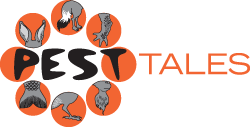Lesson Plan
Unit 3 — PEST PROBLEMS
Online activity — Magpie madness
Setting the scene
Magpie Madness encourages students to research and select an appropriate solution to a disturbing problem experienced in Australia's parks and gardens every year.
The magpie is a common resident of most Australian towns and cities. For most of the year magpies happily live among people. However, during breeding season, a small percentage of magpies become aggressive and can attack people who stray too close to their nest. Almost all attacks are by the dominant male magpie. Note: Male magpies can be distinguished from the females by the colour of the nape or back of the neck. In males it is white while it is a light grey in females and juveniles.
Magpies are NOT a feral species in Australia but many people can still be subjected to a negative experience similar to that caused by interactions with a feral or introduced pest animal.
Although magpies are a protected species in Australia and it is an offence to harm them or their eggs in any way, they can, at times, become dangerous or exhibit socially unacceptable behaviour towards people.
This activity allows students to make appropriate decisions and engage in a realistic scenario whilst acknowledging:
- natural animal behaviour
- wildlife impacts in urban areas
- common viewpoints in society
- personal safety concerns
- the benefits of community action
- animal welfare issues
- wildlife coexisting with people.
Magpie Madness can be used to inform students, in a fun but realistic way, how to best avoid or respond to a swooping magpie in their area.
It is recommended teachers work through the activity prior to student involvement. On average the online activity takes around 40 minutes to complete.
Recommended reading for teachers
To gain further information on this topic prior to teaching it in the classroom is recommended that you examine sections of the following:
- Victorian Department of Sustainability and Environment
- South Australian Department of Environment and Natural Resources
- Australian Capital Territory Parks Conservation and Lands
Book
A great Australian book useful for introducing this topic to children:
Allen, Pamela (1996) Waddle Giggle Gargle! Penguin Books Ltd.
Aim
Students are guided by research opportunities (using computer based technologies) and a selection process to effectively deal with a swooping magpie in their neighbourhood park.
Student outcomes
Students will:
- participate in accurate and detailed research
- investigate a problem solving activity using digital technologies
- identify the dimensions of the issue, including problems, how they impinge on people and other living things, and how they are managed
- evaluate the capacity of some animals to take advantage of environmental changes
- become aware of current scientific advances in pest control management
- acknowledge the humane treatment and welfare concerns of a pest animal
- identify issues that arise when people’s actions affect other living things
Materials
- computer
- Magpie madness online activity
- pen and paper
- craft materials
What to do
Students can work on this activity individually or in pairs.
Note:
Introduce the topic by discussing with the students any past experiences they may have had with a swooping magpie. Try to determine a common theme – for example, are magpies more likely to swoop people riding past on bikes rather than a couple walking together?
Step 1
Before students commence the activity they must carefully read through the list of instructions. These points are highlighted in upper case at the beginning of the activity (located at the ‘start’ symbol). Teacher reinforcement may be required so also familiarise yourself with the list of instructions.
Step 2
Allow students to progress at their own pace.
Step 3
The content of Magpie Madness is intended to provide students with a level of understanding on the following list of learning objectives.
- Students understand it is sometimes difficult to live with animals when their behaviour negatively affects you. Instead of removing the offending animal (which is often replaced by other offending animal soon after) people can sometimes change their actions to reduce the conflict.
- Students recognise magpies as a native bird of Australia and are therefore protected under relevant state or territory wildlife legislation. It is an offence to kill or harm a magpie, destroy its nest, eggs or young.
- Students appreciate that there are a number of native birds, not just magpies, that display swooping behaviour.
- Spur Wing Plover also known as a Masked Lapwing
- Red Wattlebird
- Black Swan
- Australian Wood Duck
- Noisy Miner
- Willie Wagtail
- Magpie-lark also known as a Peewee or Piping Shrike
- Kookaburra
- Grey Butcherbird
- Pelican
- Silver Gull
- Little Raven
Birds known to swoop to protect their nest and young include:
Other birds that are known to swoop when scavenging for food include:
Step 4
School projects
Three hard copy activities are available towards the end of the online activity.
These activity sheets are designed for students to work through as an extension on completion of Magpie Madness or as a homework assignment.
WHEN GOOD MAGPIES GO BAD
Aim – Students research and create a large format poster informing the community about swooping magpies, why they do it and ways to avoid harm.
THE MAGPIE SURVIVAL KIT
Aim – Students choose from a list of items to create a survival kit for use to survive the threat of a swooping magpie.
EYE SEE YOU (a craft exercise)
Aim – Students create a set of large staring eyes designed to ward off a potential swooping magpie.
Step 5
Once the activity has been completed, encourage further discussion amongst students to see if their opinions or behaviours have changed.
Encourage students to discuss their findings with their friends and family.
Step 6







